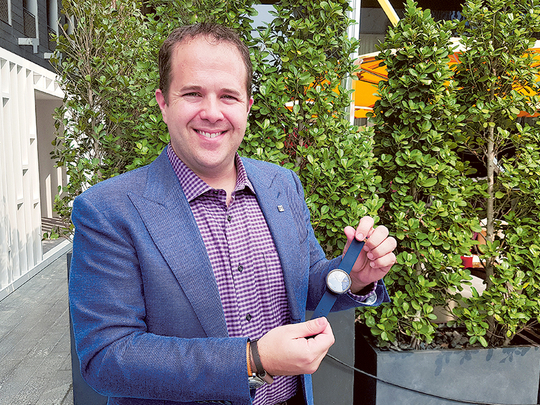
Dubai: Traditional watch manufacturers had forayed into the smartwatch segment but now they are looking to grab a bigger slice of the pie.
Last year, smartwatches overtook Swiss timepieces but watch company Fossil Group sees wearables as an additional opportunity for growth.
The company has many brands under its belt but most of its brands like Diesel, Michael Kors, Emporio Armani, Kate Spade, Misfit and Chaps have launched smartwatches this year.
The group acquired the fitness tracking company Misfit in November 2015 to strengthen its portfolio and now has 143 models, including different colours and styles, in 20 countries and 20 different languages.
They started off with their own brand, launching the Fossil Q Grant last year, which was an analogue watch with fitness tracker and vibrations to let you know of an incoming call or message, and now a majority of brands which Fossil makes have some sort of hybrid functionality.
Each brand also has its own mobile app that only connects to its smart devices, rather than using one app for all watches in every brand.
“If you think of traditional watches, there are 1,000 brands and all do one thing — tell time. In fitness trackers, there may be a dozen. What happens is over time, sensors on the body and the ability for the watch to become peripheral to the phone becomes very common, and it is all going to be about the design and the brand,” Preston Moxcey, vice-president and general manager at Misfit, told Gulf News.
He said that there are million different watch brands and million different jewellery brands while the core capabilities are the same. So, there is less differentiation of features but the breadth of design and brands is the beginning of many brands more to come into the market.
“Wearable will become a fashion accessory. When technology becomes secondary and style and fashion become primary, that is when we will know that wearables will be successful. It will eventually converge to one thing. But to successfully merge the two, we need to have the fashion design expertise and focus on it first,” he said.
He said that the growing interest in connected watches puts the company in a good position to become an early leader in the tech-fashion space.
The company will be launching its Misfit hybrid watch — Phase — in the region in January with a price tag of Dh691.
The Phase looks like a traditional watch but if someone calls or texts, the watch vibrates. The user can also programme the watch hands to move to any number when a certain person calls, apart from counting steps, monitoring sleep and push notifications to your wrist.
“It’s packed with powerfully smart features that showcase strength and style, and it delivers the information you need for today’s connected life,” he said.
Misfit Phase also works as a remote controller with the link button on the watch to control music, take pictures and interact with smart home devices, all with the touch of a button. Misfit Phase automatically updates to reflect current time zone, and, like other Misfit products, features six-month battery life.
He said that the hybrid smartwatches will bridge the gap between early adopters and regular people as it makes it easier and understandable.
“We see the two worlds [traditional watch and smartwatch] to come together for a much bigger thing. The watch business between $100 and $1,000 is roughly around $25 billion and adding to that another $20 billion wearables market, in effective, it has doubled the addressable watch market. The watch industry has grown because of the wearables,” he said.
According to research firm CCS Insight, 411 million smart wearable devices worth a staggering $34 billion will be sold in 2020 compared to $14 billion this year. Its forecast states half of all wearable tech sales over the next 12 months will be from these genres, with smartwatches making up 50 per cent of the estimated 60 million shipments.
“We see wearables as a future of our business and in future, every watch we make will be some way connected. We believe that watches should be smarter and connected and wearables will become a basic expectation of every device we sell, whether it is a handbag, jewellery, watch, etc,” Moxcey said.
The group sells 35 million watches a year and sees wearables making the smartphones more interesting.
“The fitness tracking is a big thing in the US and Asia but in the Middle East, it is the smartwatch that is getting importance,” he said.
For Lot of people, he said that payments and smart home features are more exciting rather than activity tracking. The Internet of things will be the key.
“Payments are bit tricky as different countries have different systems so for a manufacturer, it is a bit difficult,” he said.










